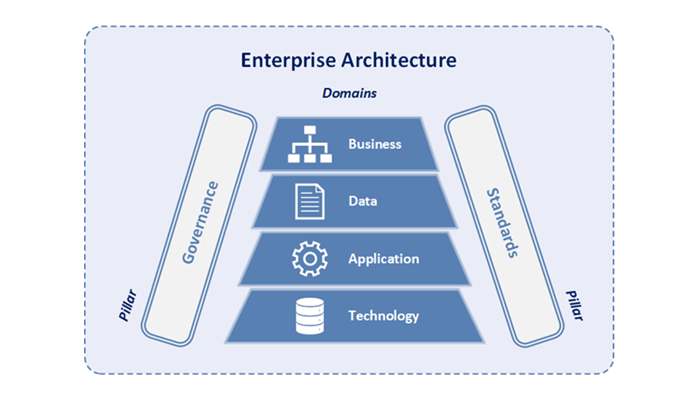Key Components of TOGAF Terminology: Breaking Down Architecture Domains and Layers

Organisations aiming to create and execute successful enterprise architectures can find and use the TOGAF framework as an extensive guide. The rich vocabulary of TOGAF is fundamental to its approach; it covers many domains, layers, and concepts that are important for architectural development and governance. Architects and stakeholders must be well-versed in TOGAF Terminology since it establishes a common language and framework for discussing architectural concepts and methods.
This blog post will discuss the fundamentals of TOGAF terminology, particularly concerning the domains and layers of architecture. This will offer valuable insights into the foundational concepts of the TOGAF framework, which is helpful whether you’re starting a TOGAF Course or want to learn more about enterprise architecture.
Table of Contents
- Understanding TOGAF Terminology
- Breaking Down Architecture Domains and Layers
- Conclusion
Understanding TOGAF Terminology
Understanding the basics of TOGAF terminology is crucial before going into the details of architectural domains and layers. An internationally accepted benchmark for business architecture is TOGAF, which stands for The Open Group Architecture Framework. Due to its systematic approach to enterprise architecture design, planning, implementation, and governance, it helps businesses align their IT strategies with their business objectives.
All the best practices, methodologies, and concepts are part of TOGAF’s organised framework. Among the many essential parts of this framework are:
Architecture Development Method (ADM)
The Architecture Development Method (ADM) is the backbone of the TOGAF methodology and provides a framework for architects to follow when creating and executing business architectures. Architectures that are functional and in line with organisational objectives result from a systematic process that includes several stages and iterations.
Architecture Domains
The many “domains” that make up an enterprise’s architecture stand for its many facets and points of view. Architectural artefacts, components, and perspectives can be organised systematically using these domains. The four primary areas of TOGAF’s architecture model are technology, data, applications, and business.
Architecture Layers
Architecture layers represent various levels of abstraction in an enterprise architecture. Providing an overarching perspective of the organization’s architecture, each layer zeroes in on element types, interactions, and functionalities. The four common architectural layers in TOGAF are the business, information, application, and technology.
Breaking Down Architecture Domains and Layers
Let’s see the TOGAF framework’s primary domains of architecture below:
Business architecture
Business architecture outlines an organisation’s business strategy’s goals, procedures, capabilities, and stakeholders. Organisational structures, value streams, performance metrics, and business models are all part of it. An organisation’s strategic plans can be better aligned with its IT investments and initiatives with the help of a well-designed business architecture.
Data Architecture
This domain concerns the organization’s data assets and how to manage and use them. Standards for data quality, data storage methods, data integration plans, data governance frameworks, and models are all part of this. To help achieve company goals and make better decisions, data architects make sure data assets are well-managed, integrated, and used.
Application Architecture
This area concerns planning, developing, and administrating the company’s software applications and related systems. Portfolios, components, interfaces, and deployment architectures of applications are all a part of it. The goal of application architecture is to ensure that software programmes are compatible with each other, industry standards, and business needs.
Technology Architecture
This area outlines the platforms and infrastructure a company uses for its technology. Hardware, networks, cloud, middleware, and security measures are all part of it. A strong, scalable, secure, and technologically aligned IT environment is essential to any successful organisation.
Now we have the TOGAF framework’s Architecture Layers below:
Business Architecture Layer
The business architecture layer represents an organisation’s architecture’s conceptual and strategic parts. A company’s objectives, procedures, capabilities, and requirements are defined in this document. The business architecture layer presents a bird ‘ s-eye view of the company’s value proposition, operational, and business model.
Information Architecture Layer
This layer stands for the conceptual and logical parts of the organisation’s data architecture. This document’s main points are principles of data governance, data flows, models, and structures. Effective management, integration, and utilisation of data assets to support business operations and decision-making are responsibilities of the information architecture layer.
Application Architecture Layer
The application architecture layer represents the logical and conceptual aspects of an organization’s application architecture. The main points are the application’s components, interfaces, and interactions. Software application design, development, and deployment must adhere to business needs and technical standards; this is where the application architecture layer comes in.
Technology Architecture Layer
This layer depicts the organisational technology infrastructure in all its technical and physical glory. The emphasis is on outlining the software platforms, network architecture, and hardware components. The technology architecture layer guarantees organisational IT resilience, scalability, security, and alignment with business goals and needs.
Conclusion
Architects and stakeholders participating in enterprise architecture projects would do well to familiarise themselves with the TOGAF framework and its essential components, particularly the domains and layers of architecture. To create enterprise architectures that are comprehensive and coherent with company goals and objectives, organisations can break down architecture into domains like business, data, application, and technology. Then, they can explore architecture layers like business, information, application, and technology. Mastering the terminology and concepts related to architecture domains and layers is an asset in driving architectural excellence and organisational success, whether you’re embarking on a TOGAF Course or want to learn more about enterprise architecture. For more information visit: The Knowledge Academy.







